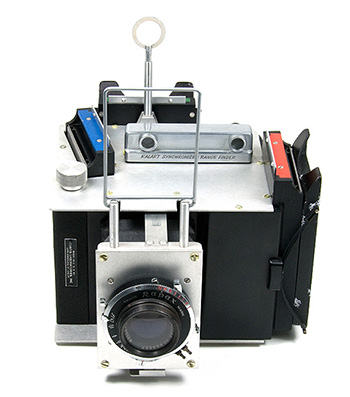
Curtis Color-Scout Camera

Curtis Color-Scout Camera
Remember black and white photographs? Sure, there they are, in the family photo album; in the old issue of LIFE magazine. Black & white was how our world was captured during photography's first hundred years. Few people today deliberately take black & white photographs. In the immediate post-WWII era when amateur photography achieved rapid growth, most snapshots were taken with black & white film. Color film was relegated to special occasions due to the greater cost of film and processing.
This is not to say that color photography is a recent invention. The Autochrome was invented over a century ago and first marketed in 1907. It was a viable method of producing color transparencies and a commercial success.
The history of color photography is an interesting field of study spanning a wide spectrum of processes, many now forgotten. Early successful methods of color photography included the ethereal Autochrome and its crisp cousin, Dufaycolor. Trichrome Carbro prints made from color separations brought vivid, archival images. Later, Kodachrome, Kodacolor and similar multi-layer films by a variety of makers gave us convenience of use. These are just a few of the color methods that were invented and practiced over the past century.
Help Wanted
I believe there is an interesting story to tell about Dr. Thomas S. Curtis and the many contributions
he made to a number of fields. I'm not a biographer and certainly not
qualified to write that story, but I think that someone should. My interest and
background is in photography and that's the part of the story I hope to flesh
out, particularly as it relates to the advancement of color photography.
If you have background information on Dr. Thomas S. Curtis or Amos W. Elliott, partners in the Thomas S. Curtis Laboratories of Huntington Park, California or Curtis Laboratories Inc. of Los Angeles, California, please contact me. Any information you share will be held in confidence and not revealed without your permission.
I am also looking for products that were sold by the Curtis companies, and perhaps more importantly, literature, ephemera, correspondence, press releases, articles written about Curtis Labs and Thomas S. Curtis - anything that will help construct a history of the companies, their products and biographies of its founders.
Please address your email to Scott Bilotta: scott@vintagephoto.tv
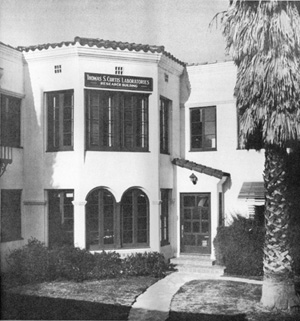
|
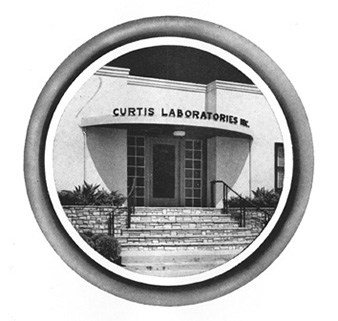
|
Curtis Laboratories Inc.
Thomas S. Curtis Laboratories of Huntington Park, California was founded in 1934 as a partnership of Dr. Curtis
and Amos W. Elliott. During the early 1940s, Curtis Laboratories Inc. of Los Angeles, California was
formed and the partnership company closed. Dr. Curtis was president and general
manager of the new company. Curtis
Laboratories Inc. was dissolved on September 17, 1959.
Thomas S. Curtis, Sc. D. was a scientist and entrepreneur who through extensive research and commercial activities worked to advance the art and science of color photography. Curtis Laboratories manufactured and sold professional and amateur color separation cameras, printing equipment, chemicals, and all the sundry elements required for color separation photography.
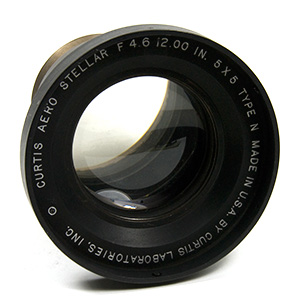
Curtis Aero Stellar Lens
Plastic Optics
During World War II Curtis Laboratories branched into the
field of plastic optics. Backed by years of research, Curtis perfected
manufacturing techniques to support the manufacture of photographic-quality plastic lenses
for the armed forces. Curtis aerial lenses were substantially lighter than
similar lenses made of glass. An example appears above.
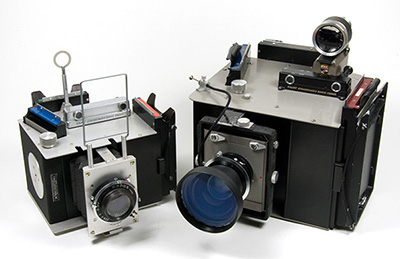
Curtis Color-Scout Cameras
Color Cameras
The Curtis Color-Scout cameras illustrated on this page are two of a variety
of color separation cameras that were manufactured by Curtis Laboratories. The
camera on the left takes 2 1/4 x 3 1/4 inch film; the camera on the right takes 4x5
inch film. Both models are double-mirror single-shot three-color cameras.
See the Color Photographica page for additional photos of Curtis color cameras.
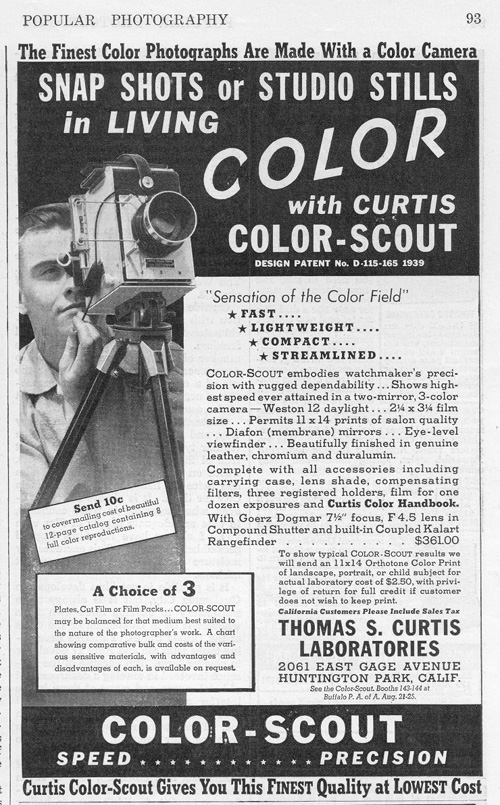
Curtis Color-Scout Advertisement
September, 1939 Issue of Popular Photography

|
Page created January 5, 2005;
updated December 20, 2020 |